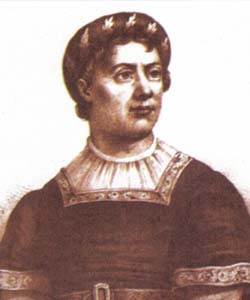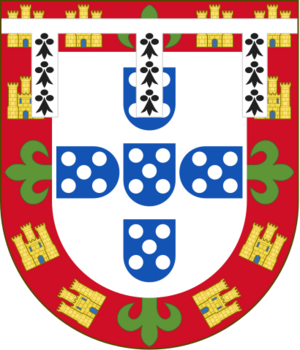Peter, Duke of Coimbra facts for kids
Quick facts for kids Infante Peter |
|
|---|---|
| Duke of Coimbra | |

This picture from the St Vincent Panels is thought to be a portrait of Peter.
|
|
| Regent of Portugal | |
| Tenure | 1439 – 1448 |
| Monarch | Afonso V |
| Born | 9 December 1392 Lisbon, Portugal |
| Died | 20 May 1449 (aged 56) Alverca, Portugal |
| Burial | Batalha Monastery |
| Spouse | |
| Issue |
|
| House | Aviz |
| Father | John I of Portugal |
| Mother | Philippa of Lancaster |
| Signature | |
Peter, Duke of Coimbra (born 9 December 1392 – died 20 May 1449) was a Portuguese prince from the House of Aviz royal family. He was the son of King John I of Portugal and his wife, Philippa of Lancaster. In Portugal, he was known as Infante Dom Pedro das Sete Partidas [do Mundo], which means "Peter of the Seven Parts of the World." This name came from his many travels around the globe. He was possibly the most traveled prince of his time. Peter also served as the regent of Portugal from 1439 to 1448, ruling the country for the young king. He was also the first Lord of several lands, including Montemor-o-Velho and Aveiro.
Contents
Early Life and Adventures
From the moment he was born, Peter was one of King John I's favorite sons. He and his brothers, including Edward (who would become king) and John, Lord of Reguengos de Monsaraz, received an excellent education. This was quite unusual for royal children back then. Peter grew up in a peaceful home, free from the usual royal family arguments.
On August 14, 1415, Peter joined his father and brothers Edward and Henry in the Conquest of Ceuta in Morocco. His mother had passed away the month before. On her deathbed, she gave each of her sons a special sword she had made for them. Peter bravely refused to become a knight until he had shown courage in battle. The next day, after the battle, he was knighted along with his brothers. He was also given the title of Duke of Coimbra. His younger brother Henry became the Duke of Viseu. These were the first dukedoms ever created in Portugal.
In 1418, after finishing a translation of a book by Seneca, Peter began a long journey across Europe. He stayed away from Portugal for ten years. He met with King John II of Castile in Spain, then traveled to Hungary. There, he met the Holy Roman Emperor Sigismund and joined his service. Peter fought with the Emperor's armies against the Turks and in wars in Bohemia. For his bravery, he was given control of the region of Treviso in Northern Italy in 1422.
In 1424, he left the Holy Roman Empire. He first met with Murad II, the Sultan of the Ottoman Empire, on the island of Patmos. Then, he continued to Constantinople, the capital of the Byzantine Empire. He was very impressed by how difficult it was for the city to defend itself against the Ottoman attacks. From Constantinople, he traveled to the Holy Land through Alexandria and Cairo.
Travels Across Europe
In 1425, Peter visited France and England. He explored the famous universities of Paris and Oxford. In 1426, he arrived in Flanders (part of modern-day Belgium), where he spent two years at the court of the Duke of Burgundy. After the Duke, Philip the Good, lost his second wife in 1425, Peter suggested his sister Isabella as a new wife. Philip sent a group to Portugal in 1428–29, which included the famous painter Jan van Eyck. Van Eyck painted two portraits of Peter's sister. Philip and Isabella eventually married on January 7, 1430. One of their sons later became Duke Charles the Bold of Burgundy.
In 1427, Peter wrote an important letter to his older brother Edward (who would become king). The letter was about "the proper administration of the kingdoms," meaning how to rule a country well. Later that year, King Henry VI of England made Peter a Knight of the Garter, a very special honor. Peter's father and older brother Edward were already Knights of the Garter.
In 1428, Peter visited his lands in Treviso and the nearby Republic of Venice. There, the Doge (leader of Venice) gave him a copy of Marco Polo's famous travel book. Peter later gave this book, along with maps of the Venetian trade routes in the East, to his younger brother Henry the Navigator. One of these maps was made by the cartographer Albertinus de Virga in 1411. It might even show North America before it was officially discovered by Europeans! This map was found in the Alcobaça Monastery, which was the main library for the Portuguese Royal family. From Venice, Peter traveled to Rome, where he met Pope Martin V. From Rome, he went to Barcelona. There, he helped arrange the marriage of his brother Edward to Eleanor of Aragon. He also arranged his own future marriage to Isabella of Urgell. Finally, he returned to Portugal.
In 1433, Peter finished his famous six-volume work, the Tratado da Virtuosa Benfeitoria, which means "Treatise of Virtuous Beneficence."
Peter Becomes Regent
When Peter's brother, King Edward I of Portugal, died in 1438, Peter's nephew Afonso V became king as a very young child. At first, the Queen mother, Eleanor of Aragon, was chosen to be regent. However, many Portuguese people did not like this choice because Eleanor was from Aragon (a region in Spain). But among the Portuguese nobles, especially those close to Peter's half-brother Afonso, Count of Barcelos, Eleanor was preferred. Some also doubted Peter's ability to lead.
However, at a meeting of the Portuguese Cortes (a kind of parliament) called by Peter's brother John, Lord of Reguengos de Monsaraz, Peter was chosen as regent. This decision pleased both the common people and the growing middle class.
In 1443, Peter tried to make peace with his half-brother Afonso by making him the Duke of Braganza. For a while, their relationship seemed normal again. But in 1445, the new Duke of Braganza became upset. This was because Peter's daughter, Isabella of Coimbra, was chosen to marry King Afonso V, instead of one of the Duke's granddaughters. Peter ignored these disagreements and continued his regency. Portugal became very successful under his leadership. During this time, the first funds were given to support explorations of the Atlantic Ocean, led by Peter's brother Henry the Navigator.
Conflict and Legacy
On June 9, 1448, Peter gave control of the country back to King Afonso V. However, King Afonso, influenced by Afonso, the Duke of Braganza, canceled all of Peter's decisions. This included the laws that had given more power to the king.
The next year, King Afonso V declared Peter a rebel, based on accusations that were later proven false. The situation became very tense, and a civil war began. It did not last long. Peter died on May 20, 1449, during the Battle of Alfarrobeira, near Alverca. How he died is still debated: some say he died fighting, while others believe he was killed by one of his own soldiers.
After Peter's death, Portugal came under the strong influence of Afonso, Duke of Braganza. However, Peter's time as regent was never forgotten. His grandson, King John II of Portugal, often spoke of Peter as a major influence on him. King John II later treated the Braganza family very harshly, perhaps as a response to the plots that led to the downfall of one of Portugal's greatest princes.
Family
In 1428, Peter married Isabella of Urgell. She was the daughter of James II, Count of Urgell. Peter and Isabella had the following children:
- Infante Peter (1429–1466), who became the Constable of Portugal and a ruler in Barcelona.
- Infante John (1431–1457), who married Charlotte of Lusignan in 1456. He became the Prince of Antioch.
- Infanta Isabella (1432–1455), who became the Queen of Portugal by marrying Afonso V of Portugal. She was the mother of John II of Portugal.
- Infante James (1433–1459), who became a Cardinal and Archbishop of Lisbon. He lived in Italy, and his tomb is in Florence.
- Infanta Beatrice (1435–1462), who married Adolph of Cleves, Lord of Ravenstein.
- Infanta Philippa (1437–1493), who became a nun.
- Catherine (around 1448 – between 1462 and 1466).
Images for kids
-
Detail from the St Vincent Panels by Nuno Gonçalves, often believed to be a portrait of Peter
See also
 In Spanish: Pedro de Portugal, duque de Coímbra para niños
In Spanish: Pedro de Portugal, duque de Coímbra para niños




